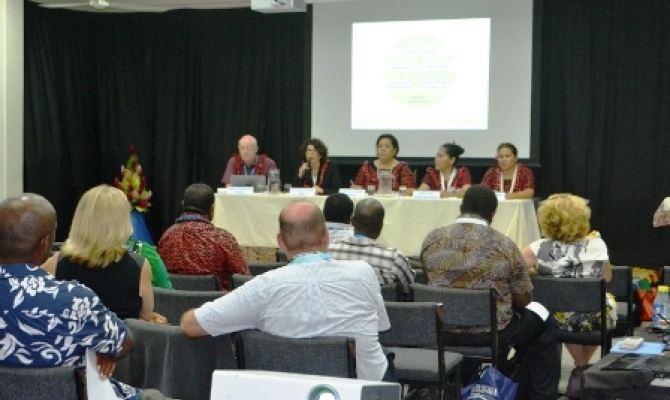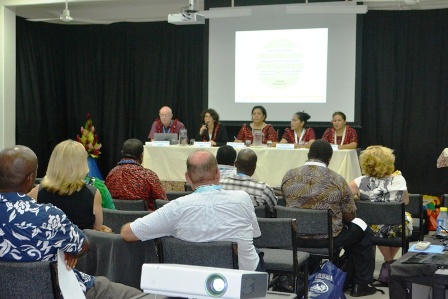
Climate Change Resilience
Makereta Komai, Editor PACNEWS
2 September 2014, Apia, Samoa - Early lessons gained from a regional project to strengthen the link between National Meteorological Service and the communities indicate the need to communicate weather information and how it impacts the population in a simple and timely manner.
Part of the strategy is to allow people at the community level to take ownership of the information and empower their people to make choices that will protect them in any extreme weather event.

The four year FINPAC project administered by Secretariat of the Pacific Regional Environment Programme (SPREP) and the Government of Finland hopes to build the capacity of National Met Services in 14 Pacific Island Countries to be able to effectively communicate climate information to communities.
Apart from empowering the Met Services and the communities, the project is also looking strengthening their relationship with the media as conduit of climate information to the people.
Co-ordinator of FINPAC at SPREP, Christina Gale said lessons from Cook Islands and Tuvalu, the first two countries to implement the project suggests that National Met Services need to link their work to action taken by communities.
"Through this partnership, communities can develop disaster resilience plans, said Gale.

This partnership has worked well for Tuvalu. Spearheaded by the National Met Service and the Tuvalu Red Cross, the project was piloted in one of the informal settlements in Funafuti, the Teone Community.
2 September 2014, Apia, Samoa - Early lessons gained from a regional project to strengthen the link between National Meteorological Service and the communities indicate the need to communicate weather information and how it impacts the population in a simple and timely manner.
Part of the strategy is to allow people at the community level to take ownership of the information and empower their people to make choices that will protect them in any extreme weather event.

The four year FINPAC project administered by Secretariat of the Pacific Regional Environment Programme (SPREP) and the Government of Finland hopes to build the capacity of National Met Services in 14 Pacific Island Countries to be able to effectively communicate climate information to communities.
Apart from empowering the Met Services and the communities, the project is also looking strengthening their relationship with the media as conduit of climate information to the people.
Co-ordinator of FINPAC at SPREP, Christina Gale said lessons from Cook Islands and Tuvalu, the first two countries to implement the project suggests that National Met Services need to link their work to action taken by communities.
"Through this partnership, communities can develop disaster resilience plans, said Gale.

This partnership has worked well for Tuvalu. Spearheaded by the National Met Service and the Tuvalu Red Cross, the project was piloted in one of the informal settlements in Funafuti, the Teone Community.
Sharing the effectiveness of engaging communities and the media in the work of National Met Service, Eseta Lauti of Tuvalu Red Cross said the 532 residents of Teone Community are now better informed about early warning systems, the impact of the weather on water and sanitation, climate change and other issues that affect their lives daily.
"The feedbacks have been positive. People in the settlement say they now have a greater understanding of hazards, risks and vulnerabilities that they were not previously aware of.
"At the same time, the National Met Service and the Disaster Management Office now have a better understanding of the needs of the communities, said Lauti.
As SPREP develops the project for the rest of the 14 Pacific Island Countries, Gale said the feedback from the different stakeholders suggests that information need to be tailor-made to suit their different needs.
In Samoa, simplifying weather reports into the local and Samoan language is a challenge, according to the assistant Chief Executive Officer in Samoa's Disaster Management Office, Filomena Nelson.
"We found that a lot of people still don't understand weather reports and cyclone warnings we put out. It is still too technical for them. Our job is to make sure that we translate these weather reports into a language that will be easily understood by people at the community level so that they can respond accordingly.
Nelson said communities in Samoa appear to understand the terms better if they are translated according to its implications on them.
"If a tropical depression is developing north-west or north-east, people want to know how far it is from where they are. What we have learnt and gathered from people after Cyclone Evan here in Samoa is to include some reference points like which side of the island is the cyclone approaching, is it close to a village etc so that people can easily relate and identify to its path.
"After a review of our early warning systems, we have included the potential impacts of the winds strengths in our special bulletins, explained Nelson.
In Cuba, the National Met Service uses visuals of the impact of similar extreme weather event to warn and prepare its population.
"That has worked well for us in Cuba and in the Caribbean, said Dr Jose Rubiera, the director of the national weather forecasting centre in Havana.
The panel discussion, organised by SPREP and the World Meteorological Organisation (WMO) and SPREP was one of the side events at the 3rd Small Island Developing States conference underway in Apia, Samoa.
"The feedbacks have been positive. People in the settlement say they now have a greater understanding of hazards, risks and vulnerabilities that they were not previously aware of.
"At the same time, the National Met Service and the Disaster Management Office now have a better understanding of the needs of the communities, said Lauti.
As SPREP develops the project for the rest of the 14 Pacific Island Countries, Gale said the feedback from the different stakeholders suggests that information need to be tailor-made to suit their different needs.
In Samoa, simplifying weather reports into the local and Samoan language is a challenge, according to the assistant Chief Executive Officer in Samoa's Disaster Management Office, Filomena Nelson.
"We found that a lot of people still don't understand weather reports and cyclone warnings we put out. It is still too technical for them. Our job is to make sure that we translate these weather reports into a language that will be easily understood by people at the community level so that they can respond accordingly.
Nelson said communities in Samoa appear to understand the terms better if they are translated according to its implications on them.
"If a tropical depression is developing north-west or north-east, people want to know how far it is from where they are. What we have learnt and gathered from people after Cyclone Evan here in Samoa is to include some reference points like which side of the island is the cyclone approaching, is it close to a village etc so that people can easily relate and identify to its path.
"After a review of our early warning systems, we have included the potential impacts of the winds strengths in our special bulletins, explained Nelson.
In Cuba, the National Met Service uses visuals of the impact of similar extreme weather event to warn and prepare its population.
"That has worked well for us in Cuba and in the Caribbean, said Dr Jose Rubiera, the director of the national weather forecasting centre in Havana.
The panel discussion, organised by SPREP and the World Meteorological Organisation (WMO) and SPREP was one of the side events at the 3rd Small Island Developing States conference underway in Apia, Samoa.